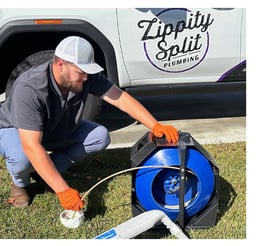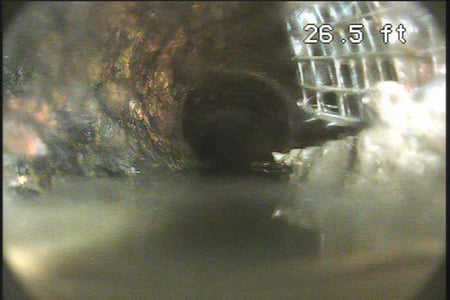 When Adam Hoffmann of Zippity Split Plumbing in Charleston, South Carolina got a call from a local homeowner with a clogged sewer line, he could tell the owner was already frustrated. Houses in downtown Charleston are unique, as many are on split lots with “half” addresses. Many of these homes have very old pipes, and often share sewer systems with their neighbors, making servicing them and troubleshooting a complex undertaking. The 4” pipe under the home of the owner who called Hoffmann had recently been redone, replacing an old cast iron line. Having had the line snaked 3 times already by other companies, calling Zippity Split was the owner’s fourth attempt in a week to get the issue resolved. Hoffmann knew the situation would call for a detail-oriented approach and looking beyond the obvious.
When Adam Hoffmann of Zippity Split Plumbing in Charleston, South Carolina got a call from a local homeowner with a clogged sewer line, he could tell the owner was already frustrated. Houses in downtown Charleston are unique, as many are on split lots with “half” addresses. Many of these homes have very old pipes, and often share sewer systems with their neighbors, making servicing them and troubleshooting a complex undertaking. The 4” pipe under the home of the owner who called Hoffmann had recently been redone, replacing an old cast iron line. Having had the line snaked 3 times already by other companies, calling Zippity Split was the owner’s fourth attempt in a week to get the issue resolved. Hoffmann knew the situation would call for a detail-oriented approach and looking beyond the obvious.
Upon arriving at the site and starting the job, Hoffmann immediately deployed his MyTana MS11-NG2 inspection system. “My camera is the most essential tool I have, and it always stays in my main truck,” he said. After poking a hole through an obstruction to get the clogged line draining, Hoffmann sent the camera back in and quickly discovered an odd blockage further down the line: bundles of chicken wire. The owner explained that a pest control company patched the old, abandoned cast iron line with chicken wire to deal with a rat problem. However, as that line was no longer in use, the owner was confused about how the chicken wire was ending up in the new pipe.
After inspecting further, and realizing he was seeing portions of the cast iron line in his camera view, Hoffmann uncovered the problem: the company that had replaced the old pipe had not, in fact, replaced much at all. The new pipe only went for a short distance before tying back into the previous line. This meant that water was indeed flowing through the old pipe and pulling the chicken wire along with it.

Hoffmann suspected that as this line was located in the crawl space, the installer likely didn’t want to dig up under the crawl space and probably didn’t have trenchless rehab capability. All of the pipes the owner was able to see were new, so he had assumed the work had been done properly. However, the issue did seem to be contained to the crawl space area. “Luckily, though the homes share part of the line, the neighbor in this situation was not having any issues,” Hoffmann said.
Hoffmann was able to show the owner real time images from the camera via his tablet and explain the situation, something he says helped gain the owner’s trust. “Especially after his recent experiences with other companies, it was important to me that he trusted me as a contractor,” Hoffmann said. Ultimately, the owner opted to have Hoffmann shoot a new liner into the pipe to get the drain lines back in working order.
With that solved, Hoffmann turned to carefully cleaning out the old pipe to prepare for relining. He again deployed the MS11 throughout the process, which helped avoid potential problems when cleaning old iron pipes. Hoffmann was able to see that as he worked, the old pipe was very frail. With Hoffmann’s experience in relining and the ability to see the precise condition of the line through the camera, he knew a regular level of cleaning would not work here. He quickly stopped work to discuss options with the homeowner. “Without that camera and the ability to see what was going on, the line would have collapsed with traditional chain descaling,” he explained.

The homeowner opted to move ahead, trusting Hoffmann’s cleaning and relining expertise. The camera helped inform Hoffmann’s choice of materials based on what he could see. Relining was successful, and Hoffmann was able to finish cleaning the rest of the new pipe to prevent any more problems from popping up. Additionally, using the MS11 with MyTana’s 512+ Locator, Hoffmann was able to discover that the owner had another cleanout location and other access points he was previously unaware of, having become blocked and buried over the years. Hoffmann was able to open these up for use in future situations. The job was finished with a post-work inspection to make sure the system flushed properly, again using the MS11 throughout.
At MyTana, we find most customers are looking for a camera that checks four boxes: clear imagery, portability (to easily get to indoor access points and move around to others), flexible yet durable push-rod (to get around bends with sturdy deployment), and connectivity (the ability to display the video feed on other devices). All are important to Hoffmann on any small-diameter job he does. No matter what task he’s doing – preparing quotes, clearing obstructions, cleaning, prepping for lining, reinstating laterals, or checking over a completed job – clear video is essential. “With small diameter work, having that camera in place at every step of the process is vital,” Hoffmann said. “My camera is almost always in the line during a job unless a liner is being put in.”



